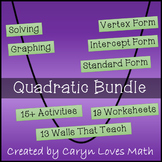Matching Graphs of Parabola with Quadratic Equations Review Activity
- PDF
What educators are saying
Also included in
- All My Algebra Activities. Over 40 Activities (many with multiple levels). Over 200 Walls That Teach. Walk-Around Activities - Domino Like Matching - Sorts - Interactive Bulletin Board Ideas - Practice SheetsActivities Covers:*Absolute Value Functions (1 and 2 variables) - solving - evaluating -Price $200.00Original Price $259.20Save $59.20
- This quadratic bundle several games, sorts, worksheets and walls that teach. Each activity includes direction, teaching ideas, printing instructions along with keys. Many activities have multiple ways to use to make them more versatile.The topics:1) Finding quadratic equations given 2 zeros. -DPrice $32.00Original Price $48.50Save $16.50
- That's right. All my math items (Algebra ~ Geometry). That's over a $100 savings from purchasing everything individually.I have noticed many teachers are buying multiple items in my store so to save you time AND money. Everything Math for sale in my store is included in this one product. This prPrice $280.00Original Price $403.20Save $123.20
Description
This matching activity matches quadratic equations in standard and vertex form with their graph. There are 4 levels to the activity, plus several alternative uses.
Students can graph the equation then look for the matching graph, or they can take a graph find the matching equation. Equations are in both standard and vertex form. You can also have student match the equations together to work on changing equations from one form to the other. This sort can be used if you have the students graph using transformations or if they find the vertex and 4 more points.
Alternate Ideas and Uses for graphs
- Match equations together (vertex to standard)
- Have student decide from the graphs if the determinate is positive, negative or zero
- Students can identify the x-intercepts in order to find the zeros of the function
- Students can identify the vertex, axis of symmetry, minimum or maximum value
- Students can find domain and range
This sort (matching game) has 4 levels
Level 1: Set A
- The graphs and equations are only translations: horizontal, vertical, or both
- For all equations, a=1
Level 2: Set B
- The graphs and equations show translations and reflections across the x-axis
- For all equations, a = 1 or -1
- Half the graphs from A plus 8 new ones
Level 3: Set C
- The graphs and equations show translations, reflections across the x-axis and dilation (stretching and shrinking)
- For all equations, a doesn't equal 1 or -1
- All new graphs
Level 4: Set D
- Includes all types of transformations: translations, reflections and dilations.
- a = anything
- This is a combination of the 3 previous sets.
This matching sort is designed to reduce chances of getting it right by guessing. The cards are very similar. For instance, 1 card shifts to the right 3, another to left 3, another up 3, and another down 3. Students must know which direction to shift based on the equation and not because it was the only one that moved 4 units. Also I have switched some values around to make sure student understand where the shift is up or to the right (right 2 up 3 or right 3 up 2). You will have a good idea if students understand the concept after they have completed the matching exercise.
Differentiation Options
Each level can be used individually
after the lesson on that particular topic (translations, reflections, dilations).
They can also be used for differentiated instruction. As a class you may be on reflections, but some students are still struggling with translations. So when the class is doing the level 2 sort, those students can be completing the level 1 sort. As far as everyone is concerned they are completing the same assignment, they don't realize that they are working at different levels. Having students work at their own level increases their confidence.
Possible Uses:
- Review station for test
- Math Station for student that have completed their work
- Mid-Lesson Practice
- End of Lesson Check for understanding
- Alternative to homework








